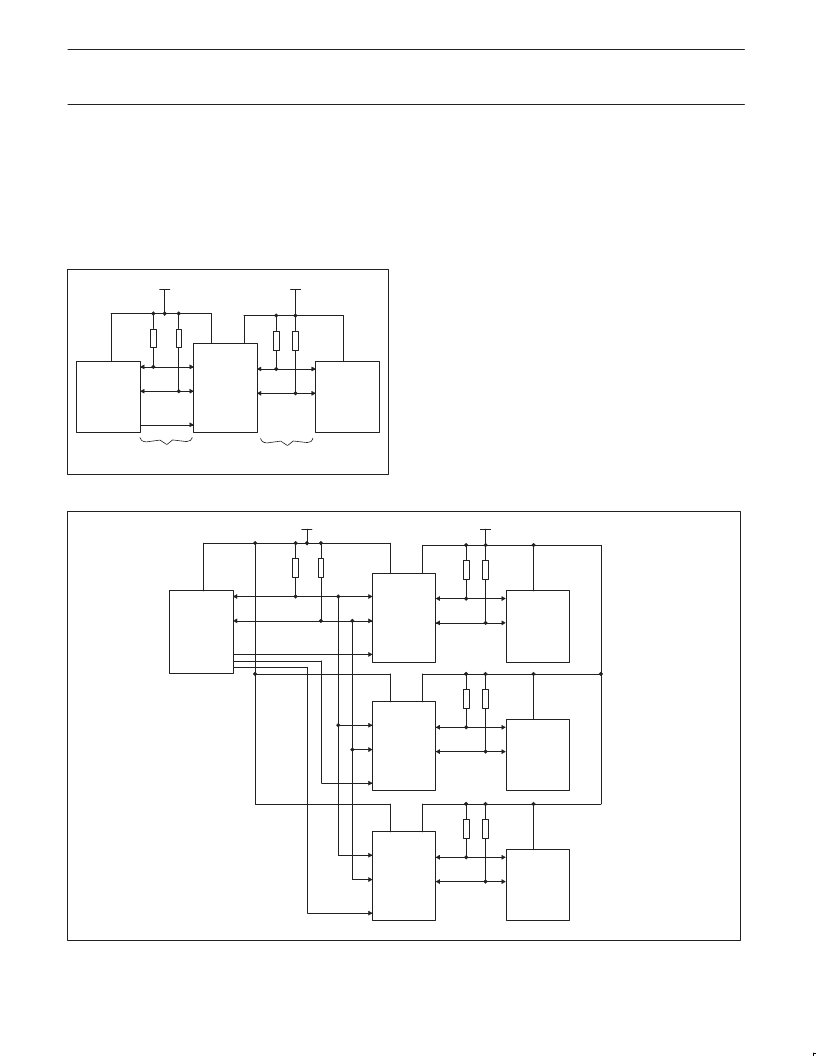- 您現(xiàn)在的位置:買賣IC網(wǎng) > PDF目錄382378 > PCA9517DP (NXP SEMICONDUCTORS) Level translating I2C-bus repeater PDF資料下載
參數(shù)資料
| 型號: | PCA9517DP |
| 廠商: | NXP SEMICONDUCTORS |
| 元件分類: | 其它接口 |
| 英文描述: | Level translating I2C-bus repeater |
| 中文描述: | SPECIALTY INTERFACE CIRCUIT, PDSO8 |
| 封裝: | 3 MM, PLASTIC, SOT-505-1, TSSOP-8 |
| 文件頁數(shù): | 4/13頁 |
| 文件大?。?/td> | 107K |
| 代理商: | PCA9517DP |

Philips Semiconductors
Product data sheet
PCA9517
Level translating I
2
C-bus repeater
2004 Oct 05
4
APPLICATION INFORMATION
A typical application is shown in Figure 3. In this example, the
system master is running on a 3.3 V I
2
C-bus while the slave is
connected to a 1.2 V bus. Both buses run at 400 kHz. Master
devices can be placed on either bus.
The PCA9517 is 5 V tolerant so it does not require any additional
circuitry to translate between 0.9 V to 5.5 V bus voltages and
2.7 V to 5.5 V bus voltages.
SW02166
BUS B
BUS
MASTER
400 kHz
SLAVE
400 kHz
PCA9517
SDA
SDAB
SDA
SCL
SCLB
SCL
EN
BUS A
3.3 V
1.2 V
SDAA
SCLA
V
CCA
V
CCB
10 k
10 k
10 k
10 k
Figure 3. Typical application
When the A side of the PCA9517 is pulled LOW by a driver on the
I
2
C-bus, a comparator detects the falling edge when it goes below
0.3V
CCA
and causes the internal driver on the B side to turn on,
causing the B side to pull down to about 0.5 V. When the B side of
the PCA9517 falls, first a CMOS hysteresis type input detects the
falling edge and causes the internal driver on the A side to turn on
and pull the A side pin down to ground. In order to illustrate what
would be seen in a typical application, refer to Figures 6 and 7. If the
bus master in Figure 3 were to write to the slave through the
PCA9517, waveforms shown in Figure 6 would be observed on the
A bus. This looks like a normal I
2
C transmission except that the
HIGH level may be as low as 0.9 V, and the turn on and turn off of
the acknowledge signals are slightly delayed.
On the B bus side of the PCA9517, the clock and data lines would
have a positive offset from ground equal to the V
OL
of the PCA9517.
After the 8th clock pulse, the data line will be pulled to the V
OL
of the
slave device which is very close to ground in this example. At the
end of the acknowledge, the level rises only to the LOW level set by
the driver in the PCA9517 for a short delay while the A bus side
rises above 0.3V
CCA
then it continues HIGH. It is important to note
that any arbitration or clock stretching events require that the LOW
level on the B bus side at the input of the PCA9517 (V
IL
) be at or
below 0.4 V to be recognized by the PCA9517 and then transmitted
to the A bus side.
SW02347
BUS
MASTER
SLAVE
400 kHz
PCA9517
SDA
SDAA
SDA
SCL
SCLA
SCL
EN
V
CCA
CCB
SDAB
SCLB
10 k
10 k
10 k
10 k
SLAVE
400 kHz
PCA9517
SDAA
SDA
SCLA
SCL
EN
SDAB
SCLB
10 k
10 k
SLAVE
400 kHz
PCA9517
SDAA
SDA
SCLA
SCL
EN
SDAB
SCLB
10 k
10 k
Figure 4. Typical star application
Multiple PCA9517 A sides can be connected in a star configuration, allowing all nodes to communicate with each other.
相關(guān)PDF資料 |
PDF描述 |
|---|---|
| PCA9518 | Expandable 5-channel I2C hub |
| PCA9530 | 2-bit I2C LED dimmer |
| PCA9531 | 8-bit I2C LED dimmer |
| PCA9532 | 16-bit I2C LED dimmer |
| PCA9533 | 4-bit I2C LED dimmer |
相關(guān)代理商/技術(shù)參數(shù) |
參數(shù)描述 |
|---|---|
| PCA9517DP,118 | 功能描述:轉(zhuǎn)換 - 電壓電平 I2C BUS REPEATER RoHS:否 制造商:Micrel 類型:CML/LVDS/LVPECL to LVCMOS/LVTTL 傳播延遲時(shí)間:1.9 ns 電源電流:14 mA 電源電壓-最大:3.6 V 電源電壓-最小:3 V 最大工作溫度:+ 85 C 安裝風(fēng)格:SMD/SMT 封裝 / 箱體:MLF-8 |
| PCA9517DP,118-CUT TAPE | 制造商:NXP 功能描述:PCA9517D Series 2.7 V to 5.5 V Level Translating I2C-Bus Repeater - TSSOP - 8 |
| PCA9517DP118 | 制造商:NXP Semiconductors 功能描述:IC I2C BUS REPEATER 5.5V 8TSSOP 制造商:NXP Semiconductors 功能描述:IC I2C BUS REPEATER 5.5V TSSOP-8 |
| PCA9517DP118 | 制造商:NXP Semiconductors 功能描述:IC I2C BUS REPEATER 5.5V TSSOP-8 |
| PCA9517DR | 功能描述:轉(zhuǎn)換 - 電壓電平 Lev-Translating I2C Bus Repeater RoHS:否 制造商:Micrel 類型:CML/LVDS/LVPECL to LVCMOS/LVTTL 傳播延遲時(shí)間:1.9 ns 電源電流:14 mA 電源電壓-最大:3.6 V 電源電壓-最小:3 V 最大工作溫度:+ 85 C 安裝風(fēng)格:SMD/SMT 封裝 / 箱體:MLF-8 |
發(fā)布緊急采購,3分鐘左右您將得到回復(fù)。